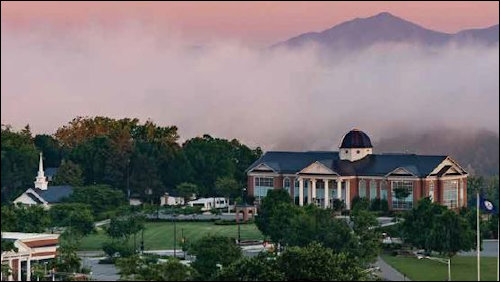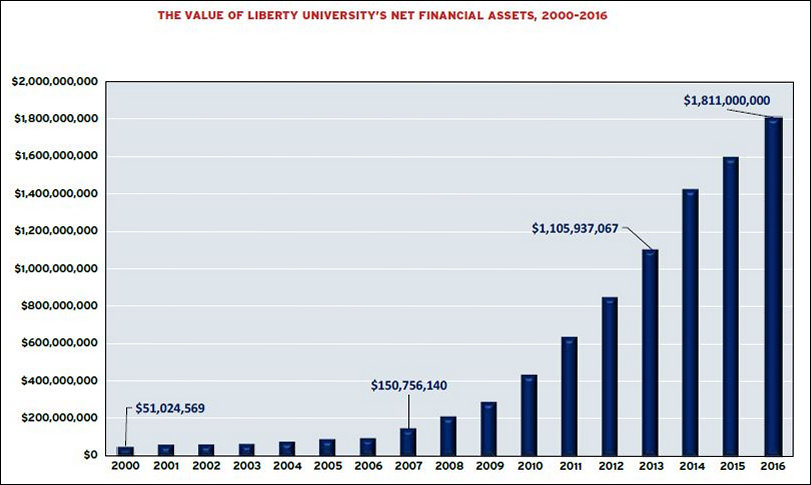The first whiff most Virginians got of Liberty University’s aspirations to national prominence was the controversial decision by President Jerry Falwell Jr. to hire Ian McCaw, the athletic director at Baylor University whose football team was mired in a sexual assault scandal.
“We want to develop ‘Champions for Christ.’ We want to provide a world-class experience for student-athletes and we want to achieve victory with integrity,” McCaw said the day of the announcement. “Then as we do that, we feel that Liberty can become really the premier Christian athletic program in the country similar to what Notre Dame is to the Catholic community and what BYU is to the Mormon community.”
In covering the story, most media focused on whether McCaw’s tenure at Baylor was consistent with Liberty’s Christian values. Passing largely unremarked upon is Falwell’s ambition of building LU into the evangelical Christian equivalent of Notre Dame and Brigham Young — both on the athletic field and in the academic realm.
LU, known to most Virginians as the creation of controversial Moral Majority leader Jerry Falwell, has grown under the tutelage of his son Jerry Jr., into the largest Christian university in the country. Since its its founding as Liberty Baptist College in 1971, when it opened its doors to 154 students, the institution has boosted enrollment to 15,000 residential students and 95,000 online students.
Judged by its growth in size and prestige, Liberty University is Virginia’s greatest higher-ed success story so far in the 21st century. Dr. James V. Koch digs into that story as part of his “2016 State of the Commonwealth Report,” published under a sponsorship by the Virginia Chamber Foundation. Koch, a former president of Old Dominion University, knows a thing or two about the business of higher education, and it shows. This is the most penetrating business analysis I’ve ever read about a Virginia university. It is must reading not only for anyone who wants to understand the LU phenomenon but to dissect the challenges facing higher education generally.
Christian values. Liberty University has distinguished itself in a highly competitive higher-ed marketplace by building a community around evangelical Christian values. Stated purposes of the institution are to glorify God and to guide students in their spiritual and moral development. Faculty members must sign a doctrinal statement affirming their belief in God and Jesus Christ as their savior. Students must adhere to an academic honor code, follow a dress code, and display “mature Christian behavior in social interaction.”
Despite its Christian emphasis, LU attracts students who otherwise would have attended public universities in Virginia, North Carolina and neighboring states. Says Koch: “In 2015, the top three schools to which students who actually enrolled at Liberty also sent their SAT and ACT scores are James Madison University, George Mason University and Virginia Tech. Interestingly, only two religious institutions were included among the top 20 competitors”
Competitive pricing. As a private institution, Liberty University does not receive state financial support, yet it has managed to price its product competitively. Indeed, the university increased tuition by less than one percentage point between 2012-2013 and 2015-16. As Koch sums up LU’s pricing strategy: “It seeks to be much less expensive than the typical independent institution and within striking distance of its major state university competitors.”
Liberty’s online pricing is even less expensive. Students can take ten online courses for a total price of $13,650, well below the $20,000 sticker price for full-time residential students.
LU students tend not to come from affluent families. Approximately half of undergraduates quality for Pell Grants for low-income students and almost two-thirds receive federal student loans. Federal financial aid to students increased from less than $20 million in the late 1990s to $800 million in 2015. “Though indirect,” Koch notes dryly, “there has been a rich flow of funds from American taxpayers to the university’s bottom line.”
Controlling costs. At other universities, LU’s student profile would be the kiss of death. More prestigious institutions rely upon a base of students from affluent households capable of paying inflated tuition. Institutions catering to lower- and middle-income students are struggling financially. How, then, has LU prospered?
By controlling costs. Liberty does not grant tenure to its faculty (except in its law school). Not only are faculty salaries somewhat lower than in peer institutions, LU faculty devote more time to teaching, as opposed to research, allowing the institution to provide a competitive quality of education. “Teaching and counseling students is considered to be the most important activity of faculty members,” Koch writes.
The refusal to grant tenure also was critical to building LU’s distance-learning program, which was was launched in its current form (Blackboard learning management system delivered by high-speed Internet connections) in the 2003 to 2005 period.
“Liberty’s faculty initially did not support online education proposals and programs — a circumstance common at other institutions,” writes Koch. “At the end of the day, the choice for faculty was simple: either help the university move forward in the area of distance education, or find a job at a different institution.”
A successful business model. The surge in online enrollments created a gusher of revenue. Since 2007 when Falwell Jr. assumed leadership, Liberty University’s net financial assets (endowment plus retained earnings) have increased in value from $150 million to $1.8 billion. Writes Koch: “Liberty has developed a very successful business model that generates impressively large cash flows. These cash flows emanate primarily from the institution’s online offerings.”
Falwell recognizes that the cash flow from online learning is vulnerable. “New online competitors have been appearing across the spectrum — some that undercut Liberty in price, others that cream skim the upper portions of the market, and still others that roughly imitate many of the things that Liberty is doing,” Koch writes. “The online education market space is becoming crowded.”
Anticipating a decline in online enrollments, Falwell proposes using cash flow to build the university endowment from about $1 billion today to $3 billion or more. If the university can sustain its current cash flow, it can achieve that goal by 2022. (Three billion dollars could make LU’s the second largest endowment in Virginia, after the University of Virginia. Because the endowment has few donor-attached strings, LU would enjoy far more flexibility in how it uses the money.)
It is less clear, however, that Liberty University’s business model is compatible with Falwell’s long-term vision. Climbing to Notre Dame/Brigham Young status likely will require a shift in priorities for faculty from teaching to scholarly output. Koch explains:
It remains to be seen if Liberty will be able to crack the upper reaches of national university rankings (and those within individual academic disciplines). For better or worse, the coin of the realm in academic rankings is a considerable cohort of faculty members who consistently publish in top-flight refereed outlets, garner externally generated research grants, and obtain external consultancies. The waves generated by the scholarship of faculty remain far more important in prestige contests than their teaching abilities.
Recruiting prestigious faculty members also will drive up salary costs, and allowing them to spend more time on research will translate into lighter teaching loads per faculty member, which in turn will require the university to hire more faculty. As online revenues shrink and faculty costs rise, cash flow will shrink.
Koch’s conclusion is apt: “There is more work to be done before the university can reach its goals, and no doubt it will be challenged significantly by the rapidly changing higher education environment. Nevertheless, few institutions have demonstrated more ability to assess higher education trends and the emerging needs of students. Thus far, and without question, it has been an impressive ride.”




